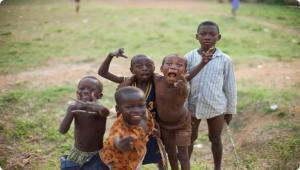
Scott Farmery, MD Consultant Anaesthetist
at Makeni Hospital, Sierra Leone
Two weeks ago, an email dropped into my hospital inbox in London. It was clearly quite persuasive because, as a direct result, I’m now sitting in a remote hospital in Sierra Leone typing this. Today's star patient is three-year-old Abubakar who had the badly contracted burn scar on his hand released and grafted by Nanak, a plastic surgeon from Birmingham I'd never met before this trip. Abubakar slept comfortably through the whole procedure with some ketamine sedation and an ultrasound-guided arm block.
The email had been forwarded from ReSurge Africa, a reconstructive surgery charity, pleading for an Anaesthetist to replace one who had unfortunately pulled out of a two-week project with just two weeks to go. Generally preferring sunshine to rain, I checked that the rota was clear and daydreamed of tropical paradises. Now, I’ve visited similar places as a student, but never as a responsible adult so, before packing sun cream and snorkel, I decided to find out a bit more. The tantalizing visions were sadly replaced with a somewhat harsher reality. In fact, what I discovered was actually quite daunting. There was no anaesthetic machine, the routine anaesthetic agent of choice was ketamine with which I am only partially familiar, there were usually significant numbers of children requiring treatment — not my normal sub-speciality. Finally, and most importantly, there was no back-up. I would be one of only 120 doctors in the entire country and the only Anaesthetist outside Freetown, the Capital. Discussion with a colleague who had returned from the same hospital two months ago provided a little relief. Crucially, the surgery was almost entirely elective so if I wasn't happy with any aspect of the operation I could cancel the case. However, seeing as cancelling everyone didn’t really seem to be a viable option. I needed a workable alternative.
Plan B was theoretically sound. It started with the familiar (ultrasound regional anaesthesia in adults) and then introduced the novel (ketamine and kids). By starting with adults having peripheral surgery while awake and under nerve block, then adding ketamine and finally including children, I could remain safely and comfortably in control throughout. While Plan B wouldn't stop me being thrown in at the deep end, at least it let me test the water temperature first and provided the armbands.*
There was just one minor detail lacking in all of this — I needed an ultrasound. The whole basis for Plan B was reliable regional anaesthesia to avoid ketamine anaesthesia until I was comfortable with it. My Anaesthetic Department was unable to spare a machine and already things started to look shaky. However, one phone call to Sonosite and the problem was solved. Sonosite would be delighted to loan me a suitable ultrasound for my trip. Sonosite also took care of the practical arrangements, including the desperate rush for a replacement machine when the hospital turned the original away at the last minute. With this vital part of the equation solved, I confirmed with ReSurge Africa that I would be happy to volunteer. I booked my flight tickets, paid large sums of money to be stabbed with various vaccines, and started taking the pills. Since then I’ve had a long plane journey, a very bumpy car journey, long days in theatre, and long nights struggling to sleep in the tropical heat. On the plus side, the hospital staff welcomed us gladly, the patients formed a (reasonably) orderly queue, we performed some vital surgery and the theatre even had air-conditioning — bliss! Perhaps I should have moved my bed there.
Exactly according to plan we identified all the patients that needed operations, deferred one or two on grounds of age (10 months old was definitely pushing things in my book) and listed the remainder in ascending order of anaesthetic complexity. It has been frantically busy and hard work, but what a learning curve! We’ve grafted chronic ulcers, released burn contractions, debrided infected wounds, repaired tendon injuries, grafted nerves, and transferred muscles to improve function. The longest case (yesterday) took 7 hours. I’ve performed upper limb blocks, the occasional spinal and eventually general anaesthesia, including children down to three years of age. I’ve definitely learnt a lot.
It’s my final day now and the Makeni theatre is comfortably familiar, the staff rip Nanak and I to shreds like old friends, and most importantly the patients are getting their operations under safe, reliable anaesthesia. It does not remotely stretch the truth to say I couldn’t have done this anything like as safely or anywhere near as comfortably without Sonosite’s kind support. So, to all involved at Sonosite, a huge thank you from the staff, patients and especially from me. It just goes to show, even in the Savannah, you still need armbands.
Dr. Farmery is an Anaesthetist who works in London’s St. George’s Hospital. He also has served on helicopter response units in London and Surrey.
* Armbands are small inflatable devices placed on swimmer’s arms to help keep the swimmer afloat.
